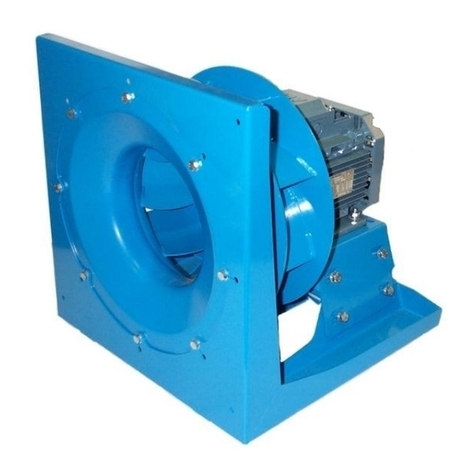Operating and Maintenance Manual - Air Conditioning Division
Make sure that the fan is always accompanied
by this manual.
6/42
the risk of ignition. For no-spark execution, TZAF FF Atex, VTZ Atex, NTHZ Atex, THLZ FF
Atex, MAZ Atex, MHZ Atex, TLZ Atex, TLI Atex, TZAF Atex, THLZ Atex, HLZ Atex, TLE Atex,
THLE Atex, KHLE Atex fans are provided with an inspection door, so that inspection and
cleaning operations can be easily carried out.
-- Clearance between rotating parts and the stationary parts
The clearance between rotating elements and the fan casing / stationary parts is the most im-
portant safety feature of ignition minimizing fans. The minimum clearances between rotating
components such as the impeller and fixed components e.g. the fan casing are at least 1 % of
the relevant contact diameters of the finished component, but are not less than 2 mm in the axi-
al or radial directions nor need to be more than 20 mm.
This clearance may be reduced to 10 % of the shaft diameter (minimum 2 mm and maximum 13
mm). Shaft seals are not subject to this provision.
Comefri provisions satisfy this requirement for all potential areas of contact listed in the previous
paragraph “Materials for rotating and stationary parts”.
Clearance between inlet-cone and shroud is indicated in the Appendix for each Comefri fan and
plenum fan series.
NOTE: the clearance may change with rotation, temperature, and due to vibrations and belt
drive tension. For this reason the installer / user must assure the correct belt tension (see par.
6.5) and check the final clearance after tensioning (see par. 4.5).
Copper plates in front of rotating parts (pulleys, hubs, back-plate, etc.) have an outer dimension
at least from 5 to 10 mm greater than rotating part dimension; clearance between the motor or
fan shaft and the edge of the passage hole is designed as indicated here above.
In case of plenum fans provided as loose components (i.e. wheel and inlet-cone) it is duty of the
installer / user to adjust the centring between inlet-cone and shroud in order to achieve a
constant clearance all around the circumference that must comply with the value indicated in
the Appendix.
-- Bearings
Bearings are designed for an L
10
life of at least 20000 hours in accordance with ISO 281. This
requirement is guaranteed only if the diameter of the pulley respects a minimal value according
to our fan-selection program Aeolus (see par. 4.3)
-- Power transmission systems
V-belts must be electrostatically conductive and must withstand short-term exposure to flames
(see par. “Fire resistance” here following). They must be declared by manufacturer to be
compliant with Atex requirements.
-- Couplings
Couplings are arranged so that the rotating part that is exposed to the potentially explosive
atmosphere does not exceed the maximum surface temperature of the fan. Couplings shall be
in compliance with Atex Directive.
-- Impeller - shaft attachment
For motor powers in excess of 15 kW a positive locking is arranged using seeger rings on the
shaft for single and double inlet fans; the use of the seeger rings at the fan shaft restricts the
maximal rotational speed: the maximal permissible rotational speed is indicated in the label. For
single inlet wheels directly coupled to the motor, positive locking is performed with a locking
screw and washer at the tapped shaft.
NOTE: special execution with a taper-bushed connection of the impeller to the shaft is used for
fans with motor power not exceeding 15 kW.
For plenum fans in setting 4 impeller hub is positive locked to motor shaft between the shaft
shoulder, with eventually a washer in front of the shoulder (ex. in case of hub in aluminum), and
a locking screw and washer at the tapped shaft end.
In case of plenum fans provided as loose components, i.e. wheel and inlet-cone, a positive
locking of impeller hub is duty of the customer.
-- Corrosion
Corrosion of fan and plenum fan components can in several ways lead to an ignition risk. The
materials used for Comefri fans and plenum fans are therefore corrosion protected by paint or
zinc-coating or manufactured in stainless steel.
The possibility of the fan and plenum fan being exposed to other corrosive chemical
constituents of the gas shall be identified by the customer and communicated to Comefri in
order to get approval or indications for special settings to be carried out.
-- Fire resistance
The materials used for the impeller, fan casing of Comefri TZAF FF Atex, VTZ Atex, NTHZ Atex,
THLZ FF Atex, MAZ Atex, MHZ Atex, TLZ Atex, TLI Atex, TZAF Atex, THLZ Atex, HLZ Atex,
TLE Atex, THLE Atex, KHLE Atex fan series and for the impeller, structure of Comefri NPL
Atex, NPA Atex, TE (in steel ) Atex plenum fan series withstand short-term exposure to flames.
(The requirement is met if the components are only partly destroyed without the onset of a self-
sustaining combustion when exposed to a (propane) Bunsen burner flame approximately 150
mm long for 30 seconds without additional air supply).
-- Protection against foreign particles
As required by Standard EN 14986, the fan and plenum fan shall be protected against the entry
of foreign particles according to grade IP20 of EN 60529.
Fans:
Comefri fans are provided with proper inlet and outlet protective guards according to grade IP20
compliant with the Standard requirement.
Plenum fans:
Comefri standard Atex execution provides plenum fans in setting 4 equipped with the proper
protection guard at the inlet and the protective enclosure at the outlet according to grade IP20
compliant with the Standard requirement. The guard of the protection enclosure is fixed at the
front panel of the structure and at an auxiliary frame provided between motor and wheel (see
sketch in the appendix).
These guards and protective enclosures shall not be tampered, nor substituted with others of
different type, causing the decay of the Comefri certification for Atex execution.




























